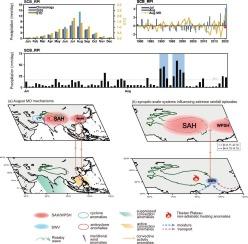2020年8月四川盆地极端降水事件的成因——基于异常月际气候差异和天气过程的分析
IF 4.4
2区 地球科学
Q1 METEOROLOGY & ATMOSPHERIC SCIENCES
引用次数: 0
摘要
2020年8月,四川盆地降水出现了自1979年以来的最高记录,超过了历史8月平均水平和2020年7月的降雨量。观测到的月间降水演变与典型的7 - 8月降水增多的气候模式形成鲜明对比。8月11 ~ 13日(E1)和15 ~ 18日(E2)发生了2次极端降水事件,E2降水中心偏北,降水偏多。这两次极端降水事件占2020年8月总降雨量的60.1%。本研究从月差(8月- 7月)的角度探讨了2020年7 - 8月南海降水的月际异常成因,并进一步揭示了两次极端降水事件的成因。与7月相比,南亚高压(SAH)的增强和东移和西太平洋副热带高压(WPSH)的东北移共同促成了8月南海上空破纪录的降水。西太平洋对流增强和印度洋对流抑制通过对西太平洋高度和南亚高压的影响间接影响降水。在两次极端事件(E1和E2)中,增强的西太平洋副高将大量水汽从热带西太平洋输送到南海。同时,来自印度洋的更多水分导致E2降水增多。所有关键过程都可以通过线性斜压模型进行验证。本文章由计算机程序翻译,如有差异,请以英文原文为准。

The causes of the extreme precipitation event in the Sichuan Basin in August 2020: A perspective from anomalous inter-monthly climate differences and weather processes
During August 2020, record-breaking precipitation occurred over the Sichuan Basin (SCB), the highest since 1979, exceeding both the historical August average and the rainfall of July 2020. This observed inter-month precipitation evolution contrasts with the typical climatological pattern, in which precipitation rises from July to August. During this period, two extreme rainfall episodes occurred—11 to 13 August (E1) and 15 to 18 August (E2)—and E2 exhibited a more northerly-located precipitation center and higher precipitation compared to E1. These two extreme precipitation episodes accounted for 60.1 % of the total rainfall in August 2020. This study investigates the causes of inter-monthly precipitation anomalies in the SCB during July–August 2020 from the perspective of the inter-monthly difference (August minus July) and further reveals the causes of two extreme precipitation episodes. Compared to July, the enhanced and eastward-shifted South Asian High (SAH) and the northeastward-shifted Western Pacific Subtropical High (WPSH) collectively contributed to the record-breaking precipitation over the SCB in August. The enhanced western Pacific convection and suppressed Indian Ocean convection influence precipitation through its effects on WPSH and SAH indirectly. During both extreme episodes (E1 and E2), abundant water vapor was transported from the tropical western Pacific to the SCB by the intensified WPSH. Concurrently, more moisture from the Indian Ocean resulted in more precipitation in E2. Moreover, non-adiabatic heating anomalies on the Tibetan Plateau facilitated the development of a southwest vortex, which enhanced upward motion over the SCB. All key processes can be validated by the Linear Baroclinic Model.
求助全文
通过发布文献求助,成功后即可免费获取论文全文。
去求助
来源期刊

Atmospheric Research
地学-气象与大气科学
CiteScore
9.40
自引率
10.90%
发文量
460
审稿时长
47 days
期刊介绍:
The journal publishes scientific papers (research papers, review articles, letters and notes) dealing with the part of the atmosphere where meteorological events occur. Attention is given to all processes extending from the earth surface to the tropopause, but special emphasis continues to be devoted to the physics of clouds, mesoscale meteorology and air pollution, i.e. atmospheric aerosols; microphysical processes; cloud dynamics and thermodynamics; numerical simulation, climatology, climate change and weather modification.
 求助内容:
求助内容: 应助结果提醒方式:
应助结果提醒方式:


